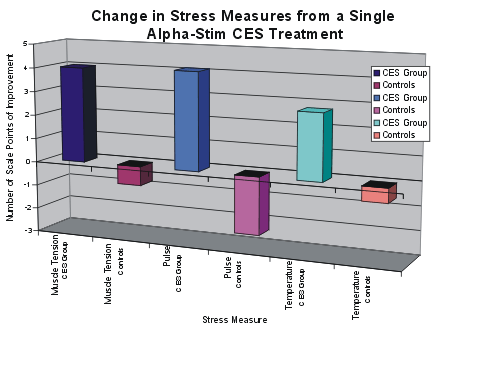Heffernan, Michael. The effect of a single cranial electrotherapy stimulation on multiple stress measures. The Townsend Letter for Doctors and Patients, 147:60-64, 1995. Presented at the Eighth International Montreux Congress on Stress, Montreux Switzerland, February 1996.
20 subjects complaining of generalized stress symptoms for at least 1 year, all of whom failed to respond to medication, were selected from the author’s private practice and divided into real Alpha-Stim CES (N = 10) and sham treatment (N = 10) in this double-blind study using double-blinding boxes. None of the treatment or sham treatment subjects perceived any sensation. Measurements of finger temperature, heart rate (HR), trapezius electromyogram (EMG), and brain capacitance were tested before, after, and 1 week following a single 100 µA, 20 minute treatment session at 0.5 Hz. Analysis was performed on each of the dependent variables using the paired t-test. All subjects in the CES treatment group showed immediate declines in EMG and heart rates with simultaneous increases in finger temperature and capacitance. These changes were all significant at the P<.05 level of confidence and confirm the experimental hypothesis that CES would reduce stress physiological stress measures. The results with CES on EMG, HR, and finger temperature were significant at the P<.025 level. The sham treatment group showed small insignificant fluctuations up and down in all dependent measures.
1 week follow-up measures in the CES group showed carryover effects in EMG and HR, but were not significant for finger temperature or capacitance. The author concluded that the psychophysiological reduction in stress response found in this study may be the probable correlate and necessary precondition for noted anxiety reduction frequently found in the CES literature. No side effects were reported.
|
